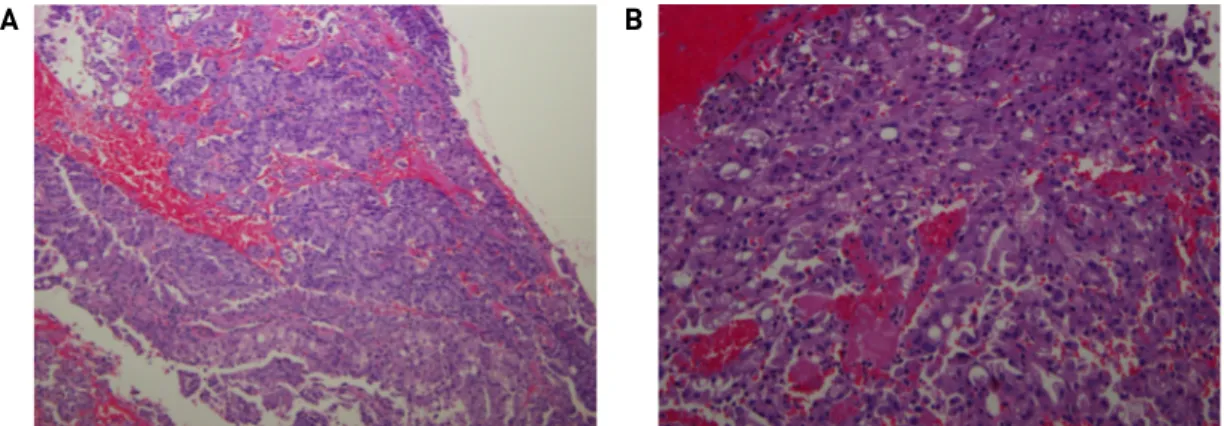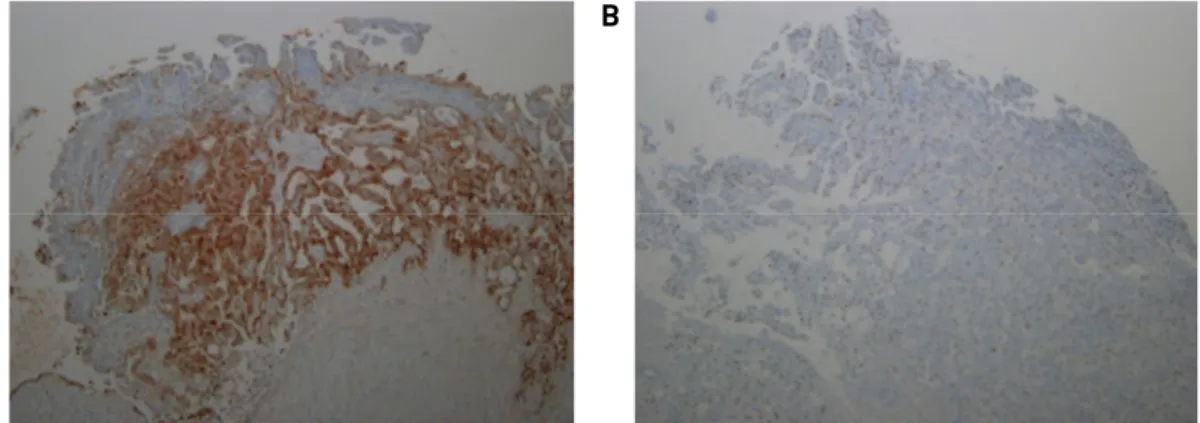- 85 - 대한두경부종양학회지, 제33권 제2호, 2017. pp.85-88
Korean Journal of Head & Neck Oncology, Vol.33, No.2
http://doi.org/10.21593/kjhno/2017.33.2.85 ISSN 1229-5183(Print) / ISSN 2586-2553(Online)
이하선에서 발생한 유선 유사 분비성 암종의 증례보고
한성민1⋅박상만1⋅권형주2⋅김지훈1+
연세대학교 원주의과대학 이비인후과학교실1, 병리학교실2
Case Report of a Mammary Analogue Secretory Carcinoma of the Parotid Gland
Sung Min Han, MD1, Sang Man Park, MD1, Hyeong Ju Kwon, MD, PhD2, Ji Hoon Kim, MD1+
Department of Otorhinolaryngology - Head and Neck Surgery1, Department of Pathology2, Yonsei University Wonju College of Medicine, Wonju, South Korea
= Abstract =
Mammary analogue secretory carcinoma (MASC) is a rare malignant tumor of the salivary gland, which was first described in 2010.1) In this case report, we describe a 62-year-old woman with a MASC of the parotid gland, who initially presented with an asymptomatic preauricular mass. At first, computed tomography (CT) and fine needle aspiration cytology were performed; these suggested a possible Warthin’s tumor but also some suspicious malignant findings. For the main treatment, adequate parotidectomy was conducted via modified Blair incision to remove the tumor. Postoperative pathology report revealed a MASC of the parotid gland. Specific MASC find- ings were observed upon immunohistochemical examination.
Key W ords:parotid gland, mammary analogue secretory carcinoma, immunohistochemistry
R eceived R e v i s e d A ccepted
: June 14, 2017 : August 22, 2017 : September 1, 2017 +Corresponding author: Ji Hoon Kim
Department of Otorhinolaryngology - Institute of Otorhinolaryngology, Hospital, Wonju Severance Christian hospital, 20 Ilsan-ro, Wonju, Gangwon-do, South Korea Tel: +82-33-741-0642 Fax: +82-33-732-8287
E-mail: jihoonkim0526@gmail.com
Introduction
A mammary analogue secretory carcinoma (MASC) is a rare tumor of the salivary gland. It has histological and genetic similarities with secretory carcinoma (SC), a rare malignancy of the breast. Skalova et al. analyzed the patho- logical findings of 16 salivary gland tumors and described a salivary gland tumor that shared the same histological features with the breast SC, which has a similar chromoso- mal translocation t(12;15)(p13;q25).1) It occurs mainly in men and is characterized by slow enlargement without pal-
pable pain.2) Although MASC presents primarily in the pa- rotid gland, they are also found at other sites, including the soft palate, submandibular gland, base of the tongue, buccal mucosa, and lips.3) Here, we report a case of MASC in the parotid gland that presented as a painless swollen mass.
Case report
A 62-year-old woman visited our clinic with a slowly enlarging mass in the left parotid area, which had been pres- ent for 2 months. At first, we performed computed tomog- raphy (CT) and cytological analysis with ultrasound-guided fine needle aspiration cytology (FNAC). Preoperative CT detected a 15.5 x 10 x 16.5 mm sized, relatively well-margi- nated, heterogeneous contrast-enhancing mass at the super- ficial lobe of the left parotid gland (Fig. 1). Preoperative FNAC suggested the possibility of either acinic cell carcino- ma or Warthin`s tumor. Based on the physical examination
- 86 - A
B
Fig. 1. A: The preoperative CT scan showing about a 15.5 x 10 x 16.5-mm sized mass at the left parotid gland. B: The mass was relatively well-margined with heterogeneous contrast enhancement within the left parotid gland superficial lobe area
A
B
Fig. 2. A: The superficial lobe of the parotid with the tumor was removed and the visually resected margin was clear. B: The intraoperative field photograph shows preservation of the facial nerve
A
B
Fig. 3. The lesion of pathology stained with periodic acid–chiff (PAS) staining. A: The tumor shows microcystic and tubular growth patterns. (x 100) B: Tumor cells revealed eosinophillic finely granular to vacuolated cytoplasm and round to oval nuclei with prominent nucleoli. (x 200)
and cytology reports, surgical excision was planned for the patient as the primary treatment. We performed an adequate (superficial lobe) parotidectomy with modified Blair incision.
During surgery, the facial nerve was safely preserved and the tumor was removed with grossly clear resection margins.
(Fig. 2). Dressing was performed twice daily to manage
- 87 - A
B
Fig. 4. The lesion of pathology analyzed with immunohistochemical staining. A: Diffuse reactivity for the S-100 protein. (x 100) B: Positive nuclear staining for GATA3. (x 100)
the wound and the patient was discharged with no apparent complications on the 8th day after surgery. The permanent pathological finding of the tumor was reported as a tumor having dimensions of 12 x 8 mm and with positive staining on periodic acid–Schiff (PAS) staining (Fig. 3). Extraparenchymal extension of the tumor was absent and lymphovascular and perineural invasion were also not identified. Tumor cells showed strong but diffuse positive staining for the S-100 protein and GATA3, but negative staining for DOG-1 upon immunohistochemical examination (Fig. 4). Although sup- plementary tests could have been helpful, the findings were considered consistent with MASC. The stage classification for this cancer was pathological T1N0M0 . Postoperative radiotherapy was not recommended because the tumor was considered to be clearly resected with adequate safe margins..
At 1-year follow-up, the patient remained without evidence of disease.
Discussion
MASC of the parotid gland has been reported to be mostly well-circumscribed and encapsulated on gross inspection.2) The imaging findings of MASC commonly include a mildly enhanced and well-circumscribed lesion. However, MASC is difficult to differentiate from other tumors through imag- ing and pathologic finding. Immunohistological features of the tumor are the most important for diagnosis. Histologically, fibrous septa divide the tumor cells and the tumor seems to have a lobulated architecture. Roshan et al. also reported several other specific histological features of MASC, including solid, tubular, cystic and/or papillary patterns with positive staining for PAS on intraluminal colloid-like secretions.3)
Key features of MASC were identified by acinar group size variation and cytoplasmic vacuolation. Positive staining for S-100, GATA3, vimentin, GCDFP-15, MUC1, adipophilin, α-amylase, DOG-1, SOX-10, P63, and mammaglobin, which is a kind of uteroglobin protein, are very important markers to distinguish from other tumors, such as low-grade mucoepidermoid carcinoma, acinic cell carcinoma, ad- enocarcinoma, and cribriform cystadenocarcinoma.4,5) Also, gene mutation is a important marker. Currently, detection of the ETV6 gene which has been found in salivary duct carcinoma with the FISH method has been considered as a diagnostic criterion for MASC.2) Chiosa et al. reported the disease age of MASC, broadly ranging from Adolescent to adult. The mean disease-free survival rate, was 92 months (95% CI, 71–115).6) Hindocha et al. suggested that if we use the different immunohistochemical findings between MASC and acinic cell carcinoma for the interpretation of each cell, it can reduce errors.7,8) The generally accepted standard treatments are entire excision of tumor by radical surgery and optional postoperative radiotherapy. In this case, it was confirmed that it was removed completely by histologic examination and it was thought that it would be more beneficial for the patient to perform closed observation with short term rather than postop RTx when considering the patient’s age.
Conclusion
MASC is a type of tumor that is mainly reported in the breast and has recently been found in the salivary gland, including the parotid gland. However, there are few cases reported and even fewer studies on factors predicting dis-
- 88 - ease progression. Clinical suspicion with knowledge of dif- ferential diagnosis is important and clear surgical resection is the mainstay of treatment for these tumors.
중심 단어:이하선, 유선 유사 분비성 암종, 면역조직화학
References
1) Skalova A, Vanecek T, Sima R, Laco J, Weinreb I, Perez-Ordonez B, et al. Mammary analogue secretory carcinoma of salivary glands, containing the ETV6-NTRK3 fusion gene: a hitherto un- described salivary gland tumor entity. Am J Surg Pathol. 2010;
34:599-608.
2) Stevens TM, Parekh V. Mammary Analogue Secretory Carcinoma.
Arch Pathol Lab Med. 2016;140:997-1001.
3) Sethi R, Kozin E, Remenschneider A, Meier J, VanderLaan P, Faquin W, et al. Mammary analogue secretory carcinoma: update on a new diagnosis of salivary gland malignancy. Laryngoscope.
2014;124:188-195.
4) Stevens TM, Kovalovsky AO, Velosa C, Shi Q, Dai Q, Owen RP, et al. Mammary analog secretory carcinoma, low-grade salivary duct carcinoma, and mimickers: a comparative study. Mod Pathol. 2015;28:1084-1100.
5) Damjanov I, Skenderi F, Vranic S. Mammary Analogue Secretory Carcinoma (MASC) of the salivary gland: A new tumor entity.
Bosn J Basic Med Sci. 2016;16:237-238.
6) Chiosea SI, Griffith C, Assaad A, Seethala RR. Clinicopathological characterization of mammary analogue secretory carcinoma of salivary glands. Histopathology. 2012;61:387-394.
7) Hindocha N, Wilson MH, Pring M, Hughes CW, Thomas SJ.
Mammary analogue secretory carcinoma of the salivary glands: a diagnostic dilemma. Br J Oral Maxillofac Surg. 2017;55:290-292.
8) Khurram SA, Sultan-Khan J, Atkey N, Speight PM. Cytogenetic and immunohistochemical characterization of mammary ana- logue secretory carcinoma of salivary glands. Oral Surg Oral Med Oral Pathol Oral Radiol. 2016;122:731-742.

